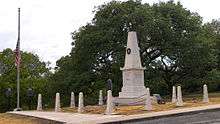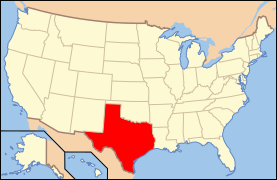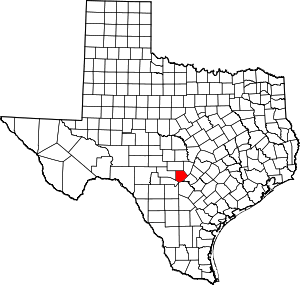Treue der Union Monument
The German-American Treue der Union Monument (Loyalty to the Union), is located in the Kendall County community of Comfort in the U.S. state of Texas. It was dedicated on August 10, 1866 to commemorate the German-Texans who died at the 1862 Nueces massacre. Thirty-four were killed, some executed after being taken prisoner, for refusing to sign loyalty oaths to the Confederacy. With the exception of those drowned in the Rio Grande, the remains of the deceased are buried at the site of the monument. This monument was the first authorized to fly the Star-Spangled Banner at half-mast in perpetuity. It was listed on the U.S. National Register of Historic Places in 1978.[1]
Treue der Union Monument | |
Texas State Antiquities Landmark | |
 Treue der Union Monument | |
 Treue der Union Monument  Treue der Union Monument | |
| Location | High Street, between Third and Fourth Comfort, Texas |
|---|---|
| Coordinates | 29°58′10″N 98°54′49″W |
| Area | less than one acre |
| Built | 1866 |
| Part of | Comfort Historic District (ID79002989[1]) |
| NRHP reference No. | 78002966[1] |
| TSAL No. | 8200000407 |
| Significant dates | |
| Added to NRHP | November 29, 1978 |
| Designated CP | May 29, 1979 |
| Designated TSAL | January 1, 1996 |
The battle
In 1862, the Confederate States of America imposed martial law on Central Texas, due to resistance to the Civil War. Jacob Kuechler served as a guide for sixty-one conscientious objectors attempting to flee to Mexico. Scottish born Confederate irregular James Duff[2] and his Duff's Partisan Rangers pursued and overtook them at the Nueces River.
Thirty-four were killed, some executed after being taken prisoner. Jacob Kuechler survived the Nueces massacre. The cruelty shocked the people of Gillespie County and surrounding areas. Two thousand took to the hills to escape Duff's reign of terror.[3]
The monument
On August 19, 1865, Eduard Degener, Eduard Steves, and William Heuermann paid $20 for a lot in Comfort, for the purpose of building a monument. The bodies of those who drowned in the massacre were never recovered. The bodies of the remaining massacre victims were recovered for burial by local residents in a mass grave on the lot purchased by Degener, Steves and Heuermann. On August 20, 1865, at Comfort, Texas, three hundred people attended the funeral for the remains of the victims of the massacre. The funeral cortege was accompanied by Federal troops who fired a salute over the mass grave. Edward Degener, father of victims Hugo and Hilmar, delivered the eulogy.[4]

With donations from local residents and families of the victims, the Treue der Union Monument was dedicated on August 10, 1866 in Kendall County. The obelisk stands twenty feet high and was constructed of native limestone by local stonemasons and several carvers.[5] The main obelisk weighs 35,700 pounds, with the top containing the original four name tablets. The United States 1865 flag has thirty-six stars, representing the number of states at the time of the monument dedication. On the lawn at the base are four name tablets in German. Inside the second course of the monument is a time capsule.[4][6][7][8]
In 1994, the Comfort Heritage Foundation oversaw a restoration conducted by Boerne stonemason Karl H. Kuhn.[9]
Names on Treue der Union Monument
| Name | Date and Place of Death | Notes |
|---|---|---|
| Leopold Bauer | 10 August 1862, Nueces River | [Note 1] |
| F Behrens | 10 August 1862, Nueces River | |
| Ernst Beseler | 10 August 1862, Nueces River | |
| Conrad Bock | Captured and murdered | Fredericksburg |
| Louis Boerner | 10 August 1862, Nueces River | Comfort |
| Wilhelm Boerner | Captured and murdered | Comfort |
| Peter Bonnet | 18 October 1862, Rio Grande | Comfort |
| Theo Bruckisch | Captured and murdered | |
| Albert Bruns | 10 August 1862, Nueces River | |
| Hilmar Degener | 10 August 1862, Nueces River | |
| Hugo Degener | 10 August 1862, Nueces River | |
| Pablo Diaz | 10 August 1862, Nueces River | |
| Joseph Elstner | 18 October 1862, Rio Grande | |
| Edward Felsing | 18 October 1862, Rio Grande | |
| Herman Flick | Captured and murdered | Fredericksburg |
| H Herrmann | 18 October 1862, Rio Grande | |
| V Hohmann | 18 October 1862, Rio Grande | |
| J.H. Kallenberg | 10 August 1862, Nueces River | Fredericksburg |
| Fritz Lange | 18 October 1862, Rio Grande | Comfort |
| August Luckenbach | Captured and murdered | Fredericksburg[11] |
| Henry Markwardt | 10 August 1862, Nueces River | Sisterdale, Cherry Spring[12] |
| A Ruebsamen | Captured and murdered | |
| L Ruebsamen | Captured and murdered | |
| Christian Schaefer Sr. | 10 August 1862, Nueces River | Fredericksburg |
| Louis Schierholz | 10 August 1862, Nueces River | |
| A. Schreiner | 10 August 1862, Nueces River | Kerrville |
| Heinrich Steves | 10 August 1862, Nueces River | Comfort |
| Heinrich Stieler | Captured and murdered | Comfort |
| F Tays | Captured and murdered | Comfort |
| Wilhelm Telgmann | 10 August 1862, Nueces River | |
| A Vater | 10 August 1862, Nueces River | |
| F Vater | 10 August 1862, Nueces River | |
| H Weyershausen | 10 August 1862, Nueces River | |
| M Weyrich | 10 August 1862, Nueces River | |
| Frank Weiss | 18 October 1862, Rio Grande | |
| Moritz Weiss | 18 October 1862, Rio Grande | |
In popular culture
The 'Treue der Union'monument (1866) has been broadly asserted to be the first monument of the Civil War, and the first Union monument raised on "Confederate" soil. {{refn|group=Note|Other Union monuments in former slave states include the Grand Army of the Republic Memorial (Judsonia, Arkansas), the Grand Army of the Republic Memorial (Siloam Springs, Arkansas), the Grand Army of the Republic Memorial Hall (St. Cloud, Florida), Union memorials and graves at Arlington Cemetery, and numerous monuments at battlefields such as at Vicksburg, Mississippi.
- In an undated entry about the Nueces massacre in The Handbook of Texas Online, the Texas State Historical Association asserts ""It is the only German-American monument to the Union in the South where the remains of those killed in battle are buried, and where, since 1866, a thirty-six star U.S. flag is permitted to fly at half-staff."[13]
- As recently as 2012, in the book Texans and War: New Interpretations of the State's Military History published by Texas A & M University Press, authors Alexander Mendoza and Charles David Grear make the claim that it is "the only shrine to the Union erected by inhabitants on former Confederate soil."[14]
- The 2008 book Civil War Sites: The Official Guide to the Civil War Discovery Trail, compiled by the Civil War Preservation Trust, lists it as "the only memorial to the Union (outside national cemeteries) in Confederate territory, and only one of six places in the nation permitted by Congress to fly the flag at half-staff in perpetuity (and the only one of these to fly the flag with thirty-six stars)."[15]
- In 2006, authors Walter D. Kamphoefner, Wolfgang Helbich Susan Carter Vogel and asserted in Germans in the Civil War: The Letters They Wrote Home that it is "the only monument of its kind in the South."[10]
According to the National Park Service, the 32nd Indiana Monument at Cave Hill National Cemetery in Kentucky "is the oldest Civil War memorial in the country." The 32nd Indiana Infantry Regiment of the Union Army was composed primarily of soldiers of German ancestry. After the December 1861 Battle of Rowlett's Station, regiment private August Bloedner created the limestone memorial in the German language as a tribute to his regiment's fatalities. Also known as the August Bloedner Monument, both the monument and the bodies of those it honors are together in the cemetery.[16]
In a 2012 article for The Southwestern Historical Quarterly, physician and US Army veteran Frank Wilson Kiel sorted known facts from lore about the monument. Citing monuments to the Union on Southern soil, he names two memorials in Tennessee, Greeneville and Cleveland, as well as three others in Texas, Denison, Dallas and New Braunfels. The claim of Treue der Union being the oldest is discredited by the 1863 Hazen Brigade Monument at Stones River National Battlefield in Tennessee and the 1861 August Bloedner Monument in Kentucky. Kiel traces the trail of misinformation back as far as 1938. Accordingly, he states that there is no protocol for flying a flag at half-mast, but rather a matter of choice for non-governmental institutions such as the Comfort Heritage Foundation. The misunderstanding stemmed from personal communications between one congressman and two different individuals associated with the monument. Congress never passed legislation on the issue.[17]
See also
- German Americans in the Civil War
- National Register of Historic Places listings in Kendall County, Texas
Footnotes
- Source book editor Dr. Walter D. Kamphoefner is a professor in the History Dept. at Texas A & M University. Dr. Kamphoefner has written numerous books regarding German families who came to Texas, all well written and documented.[10]
References
- "National Register Information System". National Register of Historic Places. National Park Service. July 9, 2010.
- Shook, Robert W. "James Duff". Handbook of Texas Online. Texas State Historical Association. Retrieved 2 February 2011.
- Kohout, Martin Donell. "Gillespie County, Texas". Handbook of Texas Online. Texas State Historical Association. Retrieved 2 February 2011.
- "Marker-Treue Der Union Monument". Texas Historic Markers. HMdb.org. Retrieved 2 February 2011.
- "List of names- Treue der Union Monument". Comfort, Texas Heritage Foundation. Retrieved 2 February 2011.
- Pohlsander, Hans A (2010). German Monuments in the Americas: Bonds Across the Atlantic. Peter Lang International Academic Publishers. p. 16. ISBN 978-3-0343-0138-1.
- Herzog, Brad (2001). States of Mind. Pocket. p. 92. ISBN 978-0-7434-1782-2.
treue der union States of Mind.
- Evans, Brent (2010). Boerne (Images of America Series). Arcadia. p. 26. ISBN 978-0-7385-7943-6.
- Little, Carol Morris (1996). A Comprehensive Guide to Outdoor Sculpture in Texas. University of Texas Press. p. 118. ISBN 978-0-292-76036-3.
- Kamphoefner, Walter D.; Helbich, Wolfgang; Vogel, Susan Carter (2006). Germans in the Civil War: The Letters They Wrote Home. Chapel Hill, NC: University of North Carolina Press – via Questia (subscription required) . p. 437. ISBN 978-0-8078-3044-4.
- "1860 Gillespie County Census Family 451- 500 So Grape Creek". Gillespie County Historical Society. Retrieved 2 February 2011.
- "1860 Gillespie County Census Family 401- 450 Cherry Spring". Gillespie County Historical Society. Retrieved 2 February 2011.
- "NUECES, BATTLE OF THE". Handbook of Texas Online. Texas State Historical Association. Retrieved September 11, 2016.
- Mendoza, Alexander; Grear, Charles David (2012). Texans and War: New Interpretations of the State's Military History. College Station, TX: Texas A & M University Press – via Questia (subscription required) . p. 140. ISBN 978-1-60344-124-7.
- Civil War Preservation Trust (2008). Civil War Sites: The Official Guide to the Civil War Discovery Trail. Guilford, CT: Globe Pequot Press. p. 310. ISBN 9780762744350.
- "Cave Hill National Cemetery Louisville, Kentucky". nps.gov. National Park Service. Retrieved September 13, 2016.
- Kiel, Frank Wilson (January 2012). "Treue der Union: Myths, Misrepresentations, and Misinterpretations". The Southwestern Historical Quarterly. Texas State Historical Association. 115 (3): 282–292. JSTOR 41617001.
External links
![]()


